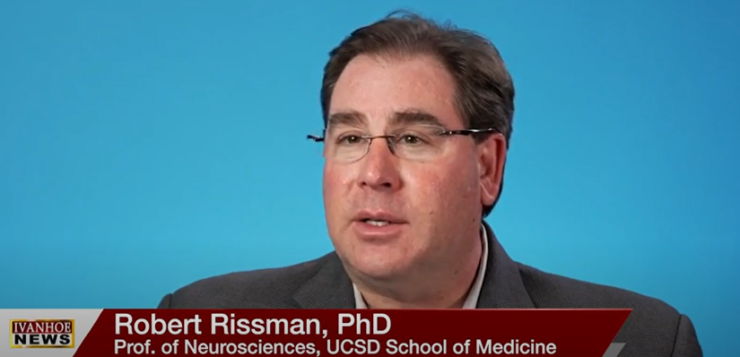Dr. Robert Rissman, MD, professor of Neurosciences at the University of California San Diego School of Medicine, talks about how an eye exam could slow the progression of Alzheimer’s.
Interview conducted by Ivanhoe Broadcast News in January 2022.
What is it about Alzheimer’s disease that makes it compelling for you?
DR RISSMAN: I started getting interested in Alzheimer’s research and neurodegenerative disease research while I was in graduate school. I think a lot of it was that I wanted something that had a practical application; not studying something for the sake of studying it but understanding how something could have an effect on somebody’s life. Alzheimer’s disease is a major neurodegenerative disorder, the most common cause of dementia in the elderly. This is something that I really felt passionate about, and I thought I could make a big contribution to.
Are prevalence rates for Alzheimer’s going up or down? How would you characterize it?
DR RISSMAN: Unfortunately, they’re only going up. Some of this is due to the fact that we are able to do early detection better now and understand who is very likely to get it, who has the earliest of symptoms. We’re able to identify people, now in the asymptomatic phases of the disease; people who have changes in their brain consistent with Alzheimer’s disease, yet don’t have any obvious symptoms. So, unfortunately, I think it’s only going up. But a good thing is our detection of it is going up, too.
How would you define amyloid plaques? What are they?
DR RISSMAN: Beta amyloid is a natural protein that is made in all of our brains. In fact, we’re all making it right now at very high levels. This protein has unknown function. It’s cleaved from a larger protein called amyloid precursor protein and it exists in cerebral spinal fluid . It’s released from your cells. For some reason, in Alzheimer’s disease, it aggregates in your brain in a very big way. Everyone, as they age, will accumulate some amyloid accumulation, some amyloid plaques, but not to the extent that Alzheimer’s disease patients do. It’s thought to be an anti-microbial agent. It’s thought to have signaling functions. It’s just never been able to be determined exactly how its job is done and what it’s really there for.
But in this current research, you’re talking about amyloid in the eye. What’s known about its presence there?
DR RISSMAN: That’s a great question. Not a whole lot. Retinal research has been going on for a number of years now, with groups using post-mortem eyes from Alzheimer patients. There have been some reports of actual brain-looking like accumulations of amyloid in the retina. But most labs have not been able to show this. What we do see is some spots that are consistent with amyloid that are immuno-reactive to beta amyloid. We aren’t sure what they’re doing there. But they do seem to be more prevalent in people who are on the track to get Alzheimer’s disease or who have cognitive impairment. In our work, we’ve tried several different imaging techniques, and they all seem to show a very similar thing. But robust plaques, we don’t actually yet see fully.
We don’t know, yet, if amyloid in the retina is strongly correlated to Alzheimer’s disease in the person, right?
DR RISSMAN: In the brain, yes. So, it’s still an open question and something that we’re actively studying. The work that we published some months ago was the initial scan from participants who were involved in an anti-amyloid treatment who were asymptomatic. This is just their first scan, the initial scan that they did at screening. As they progress in the trial and get their treatment, I think we’re going to know more about how those accumulations in the eye relate to what’s going on in the brain and how it’s impacted by a drug that reduces beta amyloid.
These retinal plaques can’t be seen. If you went to an ophthalmologist, could they see anything at this point if they were looking for it?
DR RISSMAN: They probably could not. They have some of the more basic tools that allow you to look at the vasculature of the retina or look for different structural changes. But I don’t think that the equipment they use now would allow for us to see these accumulations, which are predominantly fluorescent. We use a special compound confocal microscope to see this that’s attached to a camera. And that’s how we were able to visualize these things. But the goal would be for optometrists and ophthalmologists to be able to be the first-line people to screen for Alzheimer’s disease in their yearly meet ups with their patients.
What’s known about how far in advance of symptoms of Alzheimer’s do these retinal plaques appear?
DR RISSMAN: In terms of how early these things appear before symptoms, it’s not really known. I don’t think that there’s been a full-scale study that’s been able to track this properly. There are a couple of studies that have looked at symptomatic people and those seem to show these spots or aggregates. But in terms of when they appear before symptoms, it’s not really known. That’s one thing I think we’re going to be able to identify in the study that we’re doing right now. In the ongoing study in the A4 trial, we’re going to be able to understand whether these things are coincident with amyloid in brain, which would be ahead of cognitive changes. It’s thought that people have amyloid plaques, or accumulations, in their brain of beta amyloid, probably 10 to 20 years before they see any real symptoms. So, the question here is, is amyloid in the retina at the same time or before that?
Can you talk about if ophthalmologists or others are able to look at the retina, the differences in time, cost, availability between trying to do brain scans versus more visual ones?
DR RISSMAN: Yeah, that’s a really important point. Optometrists and ophthalmologists are doctors that patients are going to see more frequently than their neurologists. So, they should be able to see things that are going on in the retina at a much greater rate than a neurologist might be when the patients don’t come in very often. Seeing your optometrist or ophthalmologist and having a scan where they look for amyloid accumulations are going to be a much lower cost option than doing a PET scan or any kind of visualization of the brain. PET scans and MRIs are somewhat invasive and complicated techniques to do. The scans can only be done by certain sites, and they need specialized personnel to interpret the results of these scans. So, the idea of using the retina as a window to the brain is along the lines of our current work on blood-based biomarkers where we’re advancing in the field, being able to detect levels of beta amyloid in plasma and blood samples from participants and having a relationship of what would be appearing in a PET scan.
When will the A4 trial be completed, or how do you plot out your work in relation to the A4 trial?
DR RISSMAN: The A4 trial was originally slated to be approximately five years. Things became delayed with the COVID pandemic. We are expected to end the trial sometime next year, hopefully. That’s an accelerated timeline over what it would have finished on. We’re going to analyze our data that we’ve accumulated from as quickly as we possibly can and get it done. Results from that trial should be available within the next year or so. There’s a lot of data that’s coming from it, it’s not just this retinal data. This retinal study is a sub study that I proposed to the original PIs of the study. It was accepted and launched. But there’s a huge amount of data to come from this that all needs to be properly analyzed and cleaned before we know what’s going on.
Specifically, to your study, once you’ve got your data published, what would be your next step?
DR RISSMAN: The next step after we understand how amyloid in the retina is coincident with PET scanning and cognitive impairment is do a much larger, prospective study of people at the asymptomatic stage. So, we’ve enrolled about 50, but not quite 100, people in the sub study. To really see the importance of this, we would need to do a much larger study, perhaps scan people at a more frequent point rather than just once a year, like we’re doing. I could also see us trying different imaging techniques to compare these things to see which one would be the best in participants; ones that have the least invasiveness or ones that are the easiest to use and analyze.
What’s the timeline of this study?
DR RISSMAN: Sometime in 2023, the A4 trial should be ending. We should have all the data accumulated by then. It’s complicated because first, we were on a certain timeline and then, things got delayed and now, we’re trying to finish things up. It’s the analysis timeframe that’s condensed. The trial will be as long as it had planned to be. There are a lot of other asymptomatic Alzheimer’s disease trials ongoing. There are many new antibodies to be tested. So, once this trial is over, we should know where we need to go next and who we need to scan next to test this hypothesis that the retina is a window to the brain.
END OF INTERVIEW
This information is intended for additional research purposes only. It is not to be used as a prescription or advice from Ivanhoe Broadcast News, Inc. or any medical professional interviewed. Ivanhoe Broadcast News, Inc. assumes no responsibility for the depth or accuracy of physician statements. Procedures or medicines apply to different people and medical factors; always consult your physician on medical matters.
If you would like more information, please contact:
Michelle Brubaker
Sign up for a free weekly e-mail on Medical Breakthroughs called First to Know by clicking here




